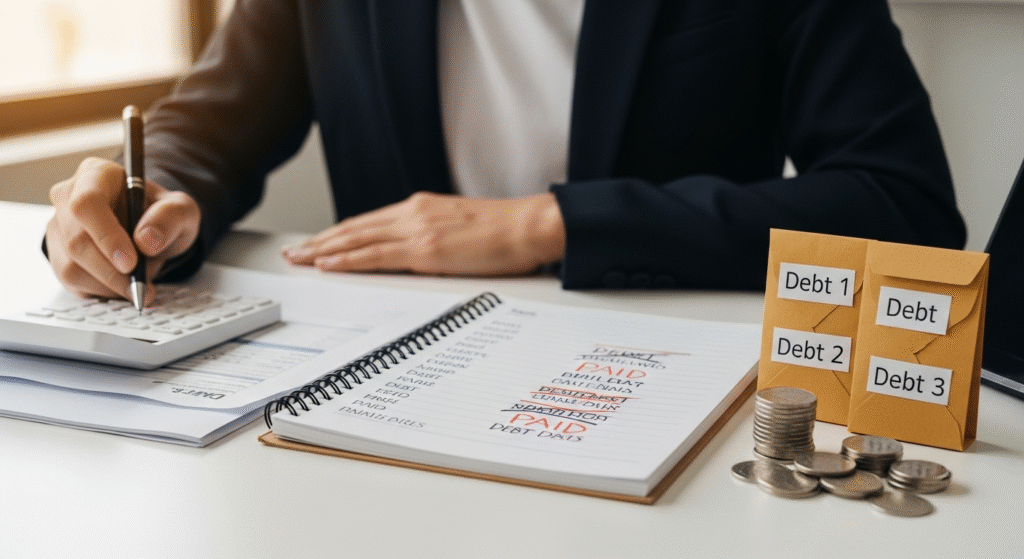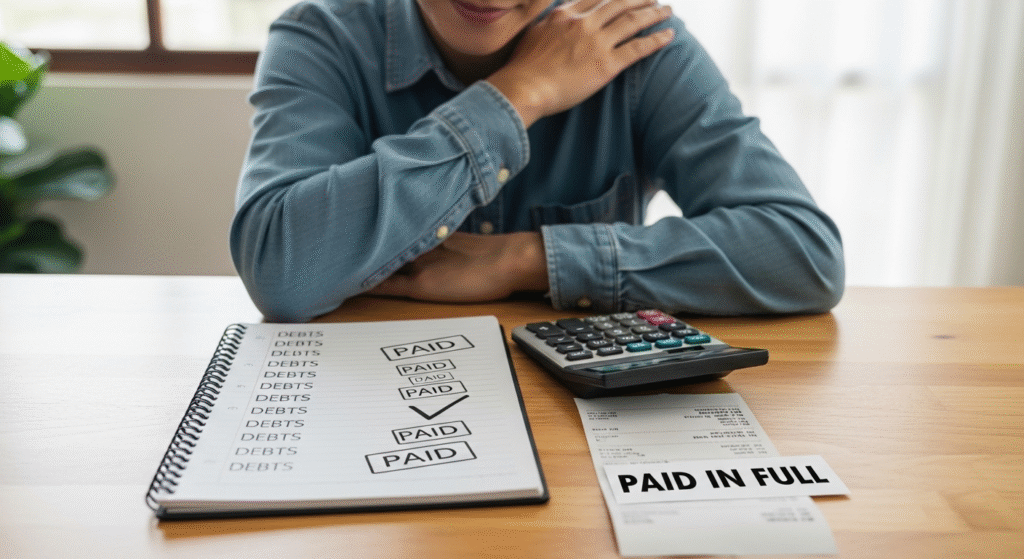
Debt Snowball Method is a popular and effective strategy to pay off debt quickly while staying motivated throughout the process. This method involves listing all your debts from the smallest balance to the largest and focusing on paying off the smallest one first. Meanwhile, you continue making minimum payments on all other debts. By clearing smaller debts first, you gain momentum and a sense of accomplishment, which encourages consistent progress and keeps you motivated to continue your repayment journey.
The Debt Snowball Method is ideal for anyone who needs a structured approach to manage debt and build confidence. In this guide, you will learn step-by-step strategies to implement this method effectively. From assessing your total debt to creating a budget, prioritizing payments, and staying disciplined, this guide covers practical tips to help you achieve financial freedom faster. Following these steps can transform debt repayment from a stressful task into an achievable plan with visible results.
Assess Your Total Debt
Before starting the Debt Snowball Method, it is important to assess your total debt carefully. Begin by making a complete list of all your debts. Include credit cards, personal loans, student loans, and any other obligations. For each debt, note the balance owed, interest rate, and the minimum monthly payment. Knowing these details gives you a clear picture of your financial situation and helps in planning repayment effectively.
Next, categorize your debts from smallest to largest balance. The Debt Snowball Method focuses on paying off smaller debts first to build momentum. By listing debts this way, you can track your progress more easily and stay motivated. Understanding the full picture of your debts ensures that no obligation is overlooked and that your repayment plan is realistic.
Assessing your total debt also allows you to identify which debts carry high interest rates. While the Debt Snowball Method prioritizes smaller balances, knowing interest rates can help you plan for the long term. This step ensures that you are informed and prepared before making any payments. Regularly updating your debt list as balances decrease is also important. The Debt Snowball Method works best when you have a clear, organized understanding of your debts and can focus on paying them off step by step.
Create a Budget for Debt Repayment

Creating a budget is a crucial step in implementing the Debt Snowball Method successfully. Start by tracking your monthly income and expenses. Include all sources of income, from salary to side jobs, and list all expenses, such as rent, utilities, groceries, and transportation. This will help you identify areas where you can cut back and free up money to put toward debt repayment.
Next, allocate a specific portion of your budget exclusively for paying off debts. The Debt Snowball Method requires you to pay the minimum on all debts while focusing extra funds on the smallest debt first. Adjust your spending habits to maximize the amount you can put toward your debt. For example, limit eating out, reduce unnecessary subscriptions, or find cheaper alternatives for regular expenses.
A well-planned budget ensures that you stay on track and do not miss payments. It also provides clarity on how much extra you can add to the smallest debt to speed up repayment. By sticking to this budget, you create a disciplined approach, making the Debt Snowball Method more effective. Tracking expenses and reviewing the budget monthly can help you stay consistent, motivated, and in control of your financial journey.
Start With the Smallest Debt First

The core principle of the Debt Snowball Method is starting with the smallest debt first. Focus on paying off this debt while continuing to make minimum payments on all other debts. By targeting the smallest debt, you can achieve quick wins that boost your confidence and motivation.
The psychological benefits of this approach are significant. Paying off a debt entirely, even if it is small, gives a sense of accomplishment and encourages you to continue using the Debt Snowball Method. These small victories keep you motivated and make the process feel less overwhelming. Celebrating each payoff, even in small ways, reinforces good financial habits and helps maintain consistency.
As you pay off the smallest debt, avoid the temptation to spend extra money elsewhere. The goal is to maximize the snowball effect by applying as much as possible to the first debt. Starting small allows you to experience success quickly, making the Debt Snowball Method more effective and sustainable over time.
Move to the Next Debt
Once the smallest debt is paid off, the Debt Snowball Method encourages you to move to the next smallest debt. Take the money you were paying on the first debt and apply it to the next one while continuing minimum payments on remaining debts. This creates a snowball effect, where payments grow larger as each debt is cleared.
Maintaining consistency is key to success. By rolling over payments, your momentum builds, making it easier to tackle larger debts over time. This step-by-step approach prevents feeling overwhelmed and ensures steady progress.
The Debt Snowball Method relies on this growing payment strategy to maintain motivation and accelerate repayment. As you see balances decreasing more quickly, the encouragement helps you stay disciplined. Following this process systematically can lead to debt freedom faster than sporadic or unstructured repayment methods. By staying consistent and applying the snowball approach carefully, you maximize both financial and psychological benefits.
Continue the Process Until All Debts Are Paid

Once you have started the Debt Snowball Method, it is essential to continue the process until all debts are fully paid. After paying off the first debt, roll the freed-up payment into the next smallest debt. This step-by-step approach allows your payments to grow over time, creating a snowball effect that speeds up repayment. Each cleared debt contributes to a larger payment toward the next one, which makes it easier to tackle bigger debts.
To stay disciplined, maintain a consistent payment schedule and avoid diverting funds to non-essential expenses. Regularly reviewing your progress helps reinforce motivation and ensures that you remain focused on your repayment goals. If your income changes or unexpected expenses occur, adjust your strategy without losing momentum. The Debt Snowball Method works best when you remain flexible but committed, understanding that setbacks may happen but can be managed.
Tracking each debt’s progress visually, using charts or apps, is helpful to see the impact of your efforts. By continuing this process patiently, you can achieve complete financial freedom. The Debt Snowball Method provides both a structured plan and the psychological boost of seeing debts disappear one by one. Staying disciplined, managing changes in income, and adhering to the method ensures long-term success in becoming debt-free and financially secure.
Avoid Accumulating New Debt
While following the Debt Snowball Method, avoiding new debt is critical. Accumulating more debt can undo your progress and make it harder to reach financial freedom. Focus on controlling spending habits and distinguishing between wants and needs. Avoid impulse purchases and rely on a realistic budget to ensure that you are not overspending.
Strategies to prevent future debt include using cash or debit cards instead of credit for daily purchases, creating an emergency fund, and planning for large expenses in advance. The Debt Snowball Method is most effective when combined with good financial habits that prevent new obligations from forming. Tracking spending regularly, setting limits, and prioritizing repayment over unnecessary purchases are essential steps.
Combine With Other Financial Strategies (Optional)
The Debt Snowball Method can be combined with other financial strategies to accelerate debt repayment. Using extra income from side hustles, bonuses, or tax refunds can increase the amount applied to your debts, helping you pay them off faster. Additionally, pairing the Debt Snowball Method with budgeting apps or financial tracking tools can provide better visibility of spending and progress.
Other strategies include creating a separate debt repayment fund, automating payments, or consolidating certain loans to reduce interest costs. While optional, combining the Debt Snowball Method with these tools enhances efficiency and provides additional motivation by showing faster results.
Using multiple approaches together ensures that your repayment journey is structured, measurable, and optimized for speed. By integrating the Debt Snowball Method with supplemental strategies, you can shorten the time it takes to become debt-free while building better financial habits for the future.
Celebrate Debt Freedom and Plan for the Future
Completing the Debt Snowball Method and paying off all debts is a major milestone. Celebrating this achievement is important for reinforcing positive financial behavior and maintaining motivation for future goals. Use this opportunity to reward yourself responsibly, reflecting on how much progress you have made.
Once debts are cleared, focus on building an emergency fund to cover unexpected expenses and prevent future financial stress. The Debt Snowball Method lays the foundation for long-term financial planning, such as investing, saving for retirement, or purchasing assets. Developing a plan for the future ensures that your hard work continues to pay off and your financial freedom is maintained.
The psychological and financial benefits of completing the Debt Snowball Method are significant. It provides confidence, reduces financial stress, and empowers you to make smarter money decisions. Planning for the future solidifies the lessons learned during repayment, ensuring lasting financial security.
Conclusion
The Debt Snowball Method is a powerful tool for paying off debt efficiently while building motivation through small victories. By focusing on the smallest debts first and gradually tackling larger balances, you create momentum that makes repayment more manageable. Combining this method with smart budgeting, disciplined spending, and optional strategies like extra income or tracking tools can accelerate results. Avoiding new debt, celebrating milestones, and planning for the future ensures lasting financial freedom. With consistency, patience, and a positive mindset, the Debt Snowball Method not only eliminates debt but also teaches valuable financial habits that empower you for a secure financial future.
FAQs
How does the Debt Snowball Method differ from the Debt Avalanche Method?
The Debt Snowball Method focuses on paying off the smallest debt first, regardless of interest rates, to build motivation. In contrast, the Debt Avalanche Method targets debts with the highest interest rates first, minimizing total interest paid. While the Snowball Method is psychologically rewarding and keeps you motivated, the Avalanche Method is mathematically faster and can save more money in interest over time.
Can the Debt Snowball Method work with multiple types of debt?
Yes, the Debt Snowball Method works with credit cards, personal loans, medical bills, or any other type of debt. The key is to list all debts from smallest to largest balance and focus on clearing one at a time. Maintaining minimum payments on other debts while targeting the smallest helps you build momentum and confidence as you systematically eliminate each obligation.
What if I have very high-interest debt, should I still use the Debt Snowball Method?
You can still use it. While high-interest debts may cost more over time, the Debt Snowball Method provides motivation by quickly eliminating smaller balances. Some people choose a hybrid approach: pay off one or two small debts first for confidence, then switch to targeting high-interest debts. The method is flexible and focuses on consistency, discipline, and maintaining momentum rather than purely minimizing interest.
How long does it typically take to pay off debt using the Debt Snowball Method?
The duration depends on your total debt, monthly repayment amounts, and income. Some people may pay off smaller debts in a few months, while larger balances could take several years. By staying disciplined, avoiding new debt, and applying any extra funds or bonuses, many users see noticeable progress within the first year, which motivates them to continue until all debts are fully cleared.
Can I combine the Debt Snowball Method with other financial strategies?
Absolutely. The Debt Snowball Method works well alongside budgeting, emergency fund building, side hustles, or investment plans. Using apps to track spending, setting automated payments, or allocating windfalls can speed up debt repayment. Combining strategies ensures you stay organized, avoid future debt, and build strong financial habits while enjoying the psychological benefits of seeing debts eliminated one by one.